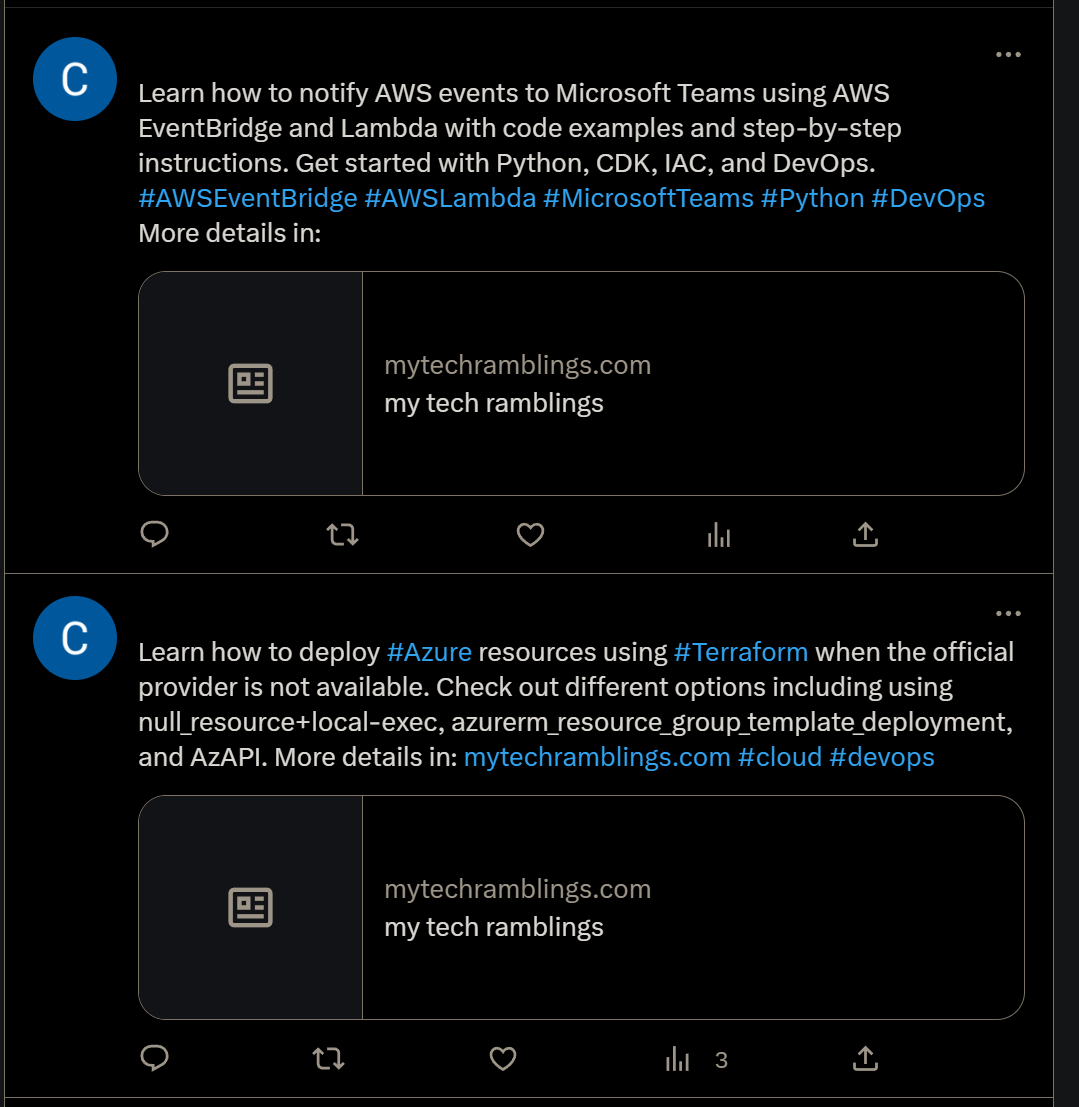This repository contains a serverless API (Azure Function) that creates tweets from a given URI.
The API reads the content of a web page URI and summarizes it into a 280-character text using Azure OpenAI, the resulting text is then used to create a tweet.
The following diagram shows how the API works.
The principle is really simple:
- The API must be called with a parameter called
uriin the Http request body, here's an example:
curl -X POST https://func-openai-azfunc-dev.azurewebsites.net/api/tweet?code=hoZ6u8lIMlhu7-Zs8gvDb04R2fXvYeapijR3YYRlgiwmAzFulsiRMA== \
-H "Content-Type: application/json" \
-d '{"uri": "https://www.mytechramblings.com/posts/deploy-az-resources-when-not-available-on-azurerm/"}'The parameter uri indicates the website from where to obtain the content.
- The API fetches the text content from the
uriwebsite. - The text content is split into multiple chunks, the reason is that the text tends to be too long to be summarized by a single request to Azure OpenAI.
- Every chunk gets summarized independently using Azure OpenAI.
- All the summarized chunks are put together in a single text and summarized again using Azure OpenAI to obtain the tweet.
- The tweet gets posted to Twitter.
- The serverless API is an Azure Function with an HTTP trigger.
- The API is built using Python and it uses LangChain alongside with Azure OpenAI to summarize the content of the blog post.
- You can use whatever LLM model Azure OpenAI offers, those values are set via configuration.
- The API uses tweepy to post the tweet to Twitter.
The following Python packages are needed:
azure-functions
tweepy
langchain
openai
tiktoken
unstructured
You can find the Azure Function source code at the repository root level.
The function needs the following configuration values to run properly:
TWITTER_CONSUMER_KEY: Twitter API consumer key.TWITTER_CONSUMER_SECRET: Twitter API consumer secret.TWITTER_ACCESS_TOKEN: Twitter API access token.TWITTER_ACCESS_TOKEN_SECRET: Twitter API access token secret.OPENAI_URL: The URL of your Azure OpenAI service.- It has the following format:
https://{base}.openai.azure.com
- It has the following format:
OPENAI_DEPLOYMENT_NAME: The Azure OpenAI model deployment name.OPENAI_APIKEY: The Azure OpenAI api key.
The Twitter API values can be found in the Twitter developer portal, meanwhile the Azure OpenAI values can be retrieved from the Azure Portal.
If you want to run the Azure Function locally, then you can put those values on the local.settings.json. If you want to deploy the function into Azure, then put the configuration values in the Function App configuration section.
- You can use any tool you want (
cURL,Postman,Insomnia, etc.), you just have to make an HTTP call to the/tweetendpoint of the API.
Here's an example using cURL to call the API running in Azure:
curl -X POST https://func-openai-azfunc-dev.azurewebsites.net/api/tweet?code=hoZ6u8lIMlhu7-Zs8gvDb04R2fXvYeapijR3YYRlgiwmAzFulsiRMA== \
-H "Content-Type: application/json" \
-d '{"uri": "https://www.mytechramblings.com/posts/deploy-az-resources-when-not-available-on-azurerm/"}'And here's another example using cURL to call the API running locally:
curl -X POST http://localhost:7071/api/tweet \
-H "Content-Type: application/json" \
-d '{"uri": "https://www.mytechramblings.com/posts/how-to-integrate-your-roslyn-analyzers-with-sonarqube"}'- If you want to test it locally, but don't want to install everything required to run an Azure Function, there is also a Jupyter Notebook in the
/notebookfolder.
Here's how the created tweets look like on Twitter:

